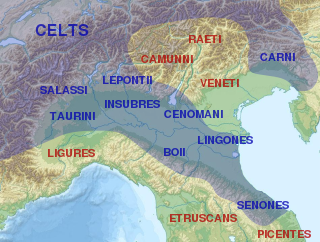
The Ligures were an ancient people after whom Liguria, a region of present-day north-western Italy, is named.
The Garfagnana is a historical and geographical region of central Italy, today part of the province of Lucca, in Tuscany. It is the upper valley or basin of the river Serchio, and thus lies between the main ridge of the Northern Apennines to the north-east and the Alpi Apuane to the west. The principal towns are Castelnuovo di Garfagnana and Barga.

The Lunigiana is a historical territory of Italy, which today falls within the provinces of Massa Carrara, Tuscany, and La Spezia, Liguria. Its borders derive from the ancient Roman settlement, later the medieval diocese of Luni, which no longer exists.
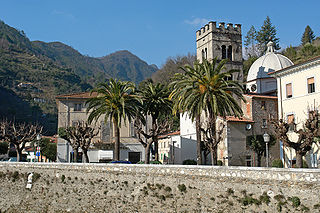
Seravezza is a town and comune belonging to the Province of Lucca, in northern Tuscany, Italy. It is located in Versilia, close to the Apuan Alps.
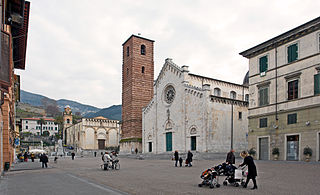
Pietrasanta is a town and comune on the coast of northern Tuscany in Italy, in the province of Lucca. Pietrasanta is part of Versilia, on the last foothills of the Apuan Alps, about 32 kilometres (20 mi) north of Pisa. The town is located 3 kilometres (1.9 mi) off the coast, where the frazione of Marina di Pietrasanta is located.

In ancient geography, the Ligures Baebiani were a settlement of Ligurians in Samnium, Italy.
Versilia is a part of Tuscany in the north-western province of Lucca and southern part of Massa-Carrara, and is named after the Versilia river. Known for fashionable Riviera resorts, it consists of numerous clubs that are frequented by local celebrities.

Camaiore is a city and comune of 32,513 inhabitants within the province of Lucca, Tuscany, central-western Italy. It stretches from the Apuan Alps to the east, to the plains and the coast of Versilia to the west.

Forte dei Marmi is a sea town and comune in the province of Lucca, in northern Tuscany (Italy). It is the birthplace of Paola Ruffo di Calabria, Queen of the Belgians from 1993 to 2013.

Luni is a comune (municipality) in the province of La Spezia, in the easternmost end of the Liguria region of northern Italy. It was founded by the Romans as Luna. It gives its name to Lunigiana, a region spanning eastern Liguria and northern Tuscany.
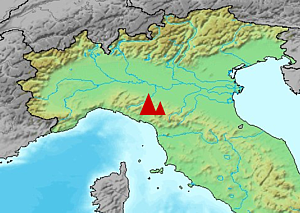
The Apuani were one of the most formidable and powerful of the Ligurian tribes who lived in ancient north-western Italy, mentioned repeatedly by Livy. From the circumstances related by him, it appears that they were the most easterly of the Ligurian tribes, who inhabited the lofty group of mountains bordering on Etruria, and appear to have occupied the valleys of the Macra and Ausar. Although they extended eastwards along the chain of the Apennines to the frontiers of the Arretines and the territory of Mutina and Bononia, the upper valley of the Macra about Pontremoli, including the area later known as Lunigiana where the Tuscan towns of Aulla, Fivizzano, Fosdinovo, Villfranca and Pontremoli are now found, and the adjoining Upper Garfagnana and Ligurian districts of Sarzana and La Spezia were their center.
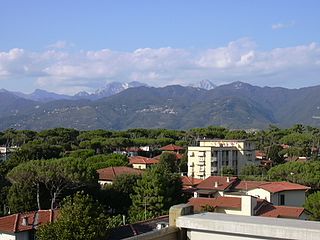
The Apuan Alps are a mountain range in northern Tuscany, Italy. They are included between the valleys of the Serchio and Magra rivers, and, to the northwest, the Garfagnana and Lunigiana, with a total length of approximately 55 kilometres (34 mi).

Volegno is a village in Tuscany in central Italy. Administratively, it is a frazione of the comune of Stazzema, in the province of Lucca. Located at 430 m over the sea level in the Alpi Apuane Regional Park, it has 65 inhabitants.
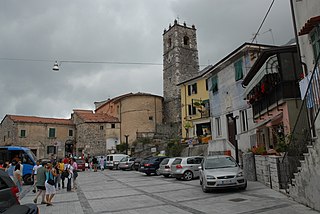
Colonnata is an Italian ancient village and a hamlet (frazione) of the comune of Carrara,. It is situated in the Apuan Alps, and is known worldwide for the pork fat delicacy Lardo di Colonnata, and for its marble quarries.

Retignano is a village of about 400 inhabitants, located on a hill in the historical Versilia, a northern area of the Italian region of Tuscany, in the municipality of Stazzema, about 430 meters above sea level. The inhabitants are called Retignanesi.
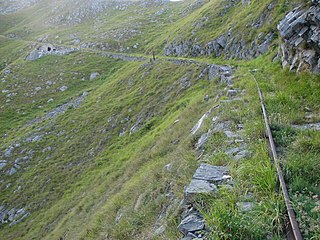
The Lizza di Piastreta, also known as Monorotaia di Piastreta, was an Italian industrial monorail serving the marble quarry of Piastreta, in the Apuan Alps, and linking it to Renara, in the municipal territory of Massa, Tuscany.

Rock shelter of the Equi Spa is located on the northern fringe of the Apuan Alps, not far from the famous Carrara marble quarries in northern Italy. The Rock shelter is located by a small the small hamlet of Equi Terme which is a currently developing tourist attraction with three selling points, an archaeological site, a natural cave system and a hiking trail along the northern fringe of the Apuan Alps.

No Cav is a journalistic term used to indicate a large Italian protest movement that arose in the early years of the 21st century composed of associations and groups of citizens united by the criticism of the Carrara marble quarries in the Apuan Alps.


















